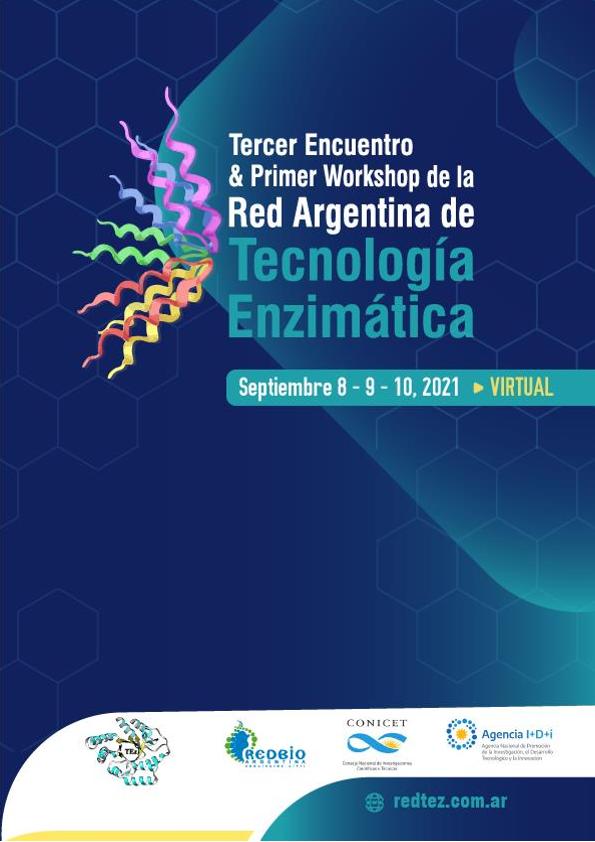Evento
Mining an intertidal sediment metagenome for fucanases for the production of oligosaccharides from brown algae fucoidans
Gonzalez, Jessica Alejandra ; Ponce, Andrea; Stortz, Carlos Arturo
; Ponce, Andrea; Stortz, Carlos Arturo ; Lozada, Mariana
; Lozada, Mariana ; Dionisi, Hebe Monica
; Dionisi, Hebe Monica
 ; Ponce, Andrea; Stortz, Carlos Arturo
; Ponce, Andrea; Stortz, Carlos Arturo ; Lozada, Mariana
; Lozada, Mariana ; Dionisi, Hebe Monica
; Dionisi, Hebe Monica
Tipo del evento:
Encuentro
Nombre del evento:
Tercer Encuentro & Primer Workshop de la Red Argentina de Tecnología Enzimática
Fecha del evento:
08/09/2021
Institución Organizadora:
Red Argentina de Tecnología Enzimática;
Título del Libro:
Tercer Encuentro & Primer Workshop de la Red Argentina de Tecnología Enzimática
Editorial:
Red Argentina de Tecnología Enzimática
Idioma:
Inglés
Clasificación temática:
Resumen
Fucoidans are a sulfated polysaccharides present in the cell wall matrix of brown algae. These polysaccharides are generally composed of a backbone of α-L-fucose residues, but they are very diverse in terms of monosaccharide composition, sulfate content and linkage patterns, i.e. α-(1,3) or α-(1,3)/α-(1,4). Fucoidans have a variety of biological activities beneficial for human health, such as immune-modulatory, antiviral, anticoagulant, antitumor, antithrombosis and antioxidant. However, the low absorption of these complex carbohydrates and their low bioavailability limit their health benefits besides their prebiotic effect. Endo-acting enzymes called fucanases depolymerize these polysaccharides, generating bioactive fuco-oligosaccharides with various biotechnological applications. So far, only two CAZy families have been described: GH107 (endo-α-1,4-L-fucanase) and GH168 (endo-α-1,3-L-fucanase). In this work, we mined putative fucanase sequences in a metagenomic dataset from intertidal sediments of Ushuaia Bay (Tierra del Fuego Island, Argentina) exposed to brown algae detritus, and selected sequences for heterologous expression and characterization. Using a series of HMMs specific for these families, we identified eight sequences homologous to the GH107 family and 32 sequences related to members of GH168 family. The relative abundance of these genes in the metagenome was one every 17,000 sequences, although probable only part of the diversity of these enzymes is currently known. Overall, 26 sequences shared low identity values (<40 % at protein level), while 5 sequences had high identity values (>80 %) with reference sequences of the database. One of the scaffold contained both GH107 and GH168 homologs, and often the genomic context of the identified sequences contained genes potentially related to fucoidan degradation, including α-fucosidases (exo-acting) and sulfatases. These results provide further evidence of the predicted function of the identified sequences. In both families, the most abundant taxonomic assignment of the scaffolds containing the identified sequences was the Planctomycetes phylum (35 % of the sequences), for which fucanase enzymes have not yet been characterized. The second most abundant taxonomic assignment was the Terrabacteria group, followed by Bacteroidetes and Proteobacteria phyla. Besides the catalytic module, domains identified in these sequences include a pectin lyase fold, carbohydrate-binding module, beta helix and domains belonging to other GH families (GH10, GH13, GH15, GH31 and GH29). Four sequences related to the GH107 family were selected for heterologous expression in Escherichia coli, three probably from members of the Planctomycetes phylum and one from the Bacteroidetes phylum. Low temperatures during expression were needed for reaching high levels of protein expression in the soluble fraction. The enzymes were purified and characterized, and fucanase activity was evaluated by carbohydratepolyacrylamide gel electrophoresis (C-PAGE). The assessed substrates were fucoidans extracted from four brown algae species of the Patagonian coast: Macrocystis pyrifera, Undaria pinnatifida, Scytosiphon lomentaria and Adenocystis utricularis. Among the four expressed genes, #113643 (potentially from a Planctomycetes) presented a high activity towards M. pyrifera fucoidan, with degradation products observed from a 30 s incubation time at 25 °C, faster than previously characterized members of the GH107 family. The enzyme was active in a wide range of temperatures (5 - 45 °C), salinities (9.5 – 861 mM NaCl) and pH (4.5 – 9). The best template for the 3D modeling of #113643 was the structure of the fucanase P5AFcnA from Psychromonas sp. SW5A (21 % identity and 70 % coverage), enzyme that is able to degrade the same substrate. The structure of M. pyrifera fucoidan is poorly defined, and very limited information is available on how the active-site topology relates to fucanase substrate specificity, in particular because substrate recognition depend not only on the glycosidic linkages but also on modifications such as sulfation patterns. Further work will include the use of substrates purified from other brown algae species, the heterologous expression and characterization of member of the GH168 family and structural analyses of the degradation products. As a result of this study, novel fucanase enzymes will be available to produce fucooligosaccharides from brown algae species of Patagonia, with nutraceutical, cosmeceutical and pharmaceutical applications.
Palabras clave:
PLANCTOMYCETES
,
FUCANASE
,
BACTERIAL
,
SEDIMENTS
Archivos asociados
Licencia
Identificadores
Colecciones
Eventos(CESIMAR)
Eventos de CENTRO PARA EL ESTUDIO DE SISTEMAS MARINOS
Eventos de CENTRO PARA EL ESTUDIO DE SISTEMAS MARINOS
Eventos(CIHIDECAR)
Eventos de CENTRO DE INVESTIGACIONES EN HIDRATOS DE CARBONO
Eventos de CENTRO DE INVESTIGACIONES EN HIDRATOS DE CARBONO
Eventos(IBIOMAR)
Eventos de INSTITUTO DE BIOLOGIA DE ORGANISMOS MARINOS
Eventos de INSTITUTO DE BIOLOGIA DE ORGANISMOS MARINOS
Citación
Mining an intertidal sediment metagenome for fucanases for the production of oligosaccharides from brown algae fucoidans; Tercer Encuentro & Primer Workshop de la Red Argentina de Tecnología Enzimática; Buenos Aires; Argentina; 2021; 68-68
Compartir



